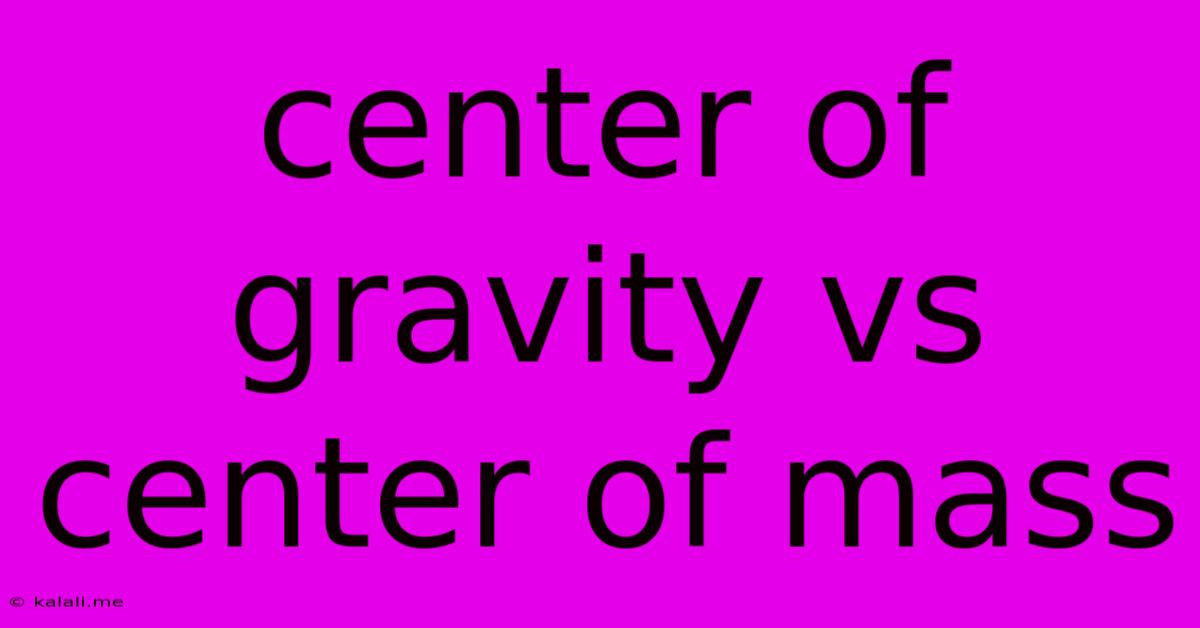Center Of Gravity Vs Center Of Mass
Kalali
May 31, 2025 · 3 min read

Table of Contents
Center of Gravity vs. Center of Mass: Understanding the Difference
Understanding the concepts of center of gravity (CG) and center of mass (CM) is crucial in various fields, from physics and engineering to sports and ergonomics. While often used interchangeably, there's a subtle yet important distinction between the two. This article will delve into the definitions, differences, and practical applications of CG and CM. This will help you understand the core concepts and differentiate between the two terms for improved comprehension and application.
What is the Center of Mass (CM)?
The center of mass (CM) is the point where the entire mass of an object can be considered to be concentrated. It's the average position of all the mass that constitutes the object. Imagine balancing a rigid object—the point at which it balances perfectly is its center of mass. For a uniform object like a sphere or a cube, the CM is at its geometric center. However, for irregular objects, the CM's location depends on the distribution of mass within the object. Calculating the CM requires considering the individual masses and their positions within the object.
Calculating the Center of Mass: The precise calculation involves integrating over the object's volume, considering its density. For simpler objects, it can be determined by finding the average of the x, y, and z coordinates weighted by the mass distribution.
What is the Center of Gravity (CG)?
The center of gravity (CG) is the point where the weight of an object can be considered to be concentrated. Weight is the force exerted on an object due to gravity. While conceptually similar to the center of mass, the CG is specifically concerned with the gravitational force acting on the object.
The Crucial Difference:
The key difference lies in the influence of gravity. In a uniform gravitational field, the center of gravity and the center of mass coincide. This is the case in most everyday situations on Earth, where gravity is essentially constant. However, in non-uniform gravitational fields, such as those experienced in space near large celestial bodies, the CG and CM will differ. The gravitational pull varies across the object, causing the CG to shift slightly.
Practical Applications:
Understanding the difference, while often negligible in everyday life, becomes crucial in specific scenarios:
- Aerospace Engineering: Designing aircraft and spacecraft requires precise calculations of the CG to ensure stability and control. The distribution of weight within the vehicle significantly impacts its flight characteristics.
- Robotics: Determining the CM and CG is essential for designing stable and maneuverable robots. Precise balancing and movement depend on accurately locating these points.
- Sports: In sports like gymnastics and diving, understanding the CG helps athletes perform more efficient and controlled movements. Shifting the CG allows for better balance and control during complex maneuvers.
- Structural Engineering: The CG plays a vital role in determining the stability of structures like buildings and bridges. Proper weight distribution is crucial for structural integrity.
In Summary:
While often used synonymously, the center of mass and center of gravity are distinct concepts. The CM represents the average position of mass, while the CG represents the average position of weight. In most terrestrial applications, they are effectively the same due to the uniform gravitational field. However, in situations with non-uniform gravity, they diverge. Understanding this difference is crucial for accurate calculations and design in various engineering and scientific fields.
Latest Posts
Latest Posts
-
How Long Does It Take For Chocolate To Harden
Jun 01, 2025
-
Best Placement For Bathroom Exhaust Fan
Jun 01, 2025
-
Pull Up Vs Pull Down Resistor
Jun 01, 2025
-
Can You Use Regular Oil After Synthetic
Jun 01, 2025
-
How To Make Espresso At Home
Jun 01, 2025
Related Post
Thank you for visiting our website which covers about Center Of Gravity Vs Center Of Mass . We hope the information provided has been useful to you. Feel free to contact us if you have any questions or need further assistance. See you next time and don't miss to bookmark.